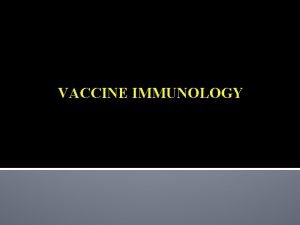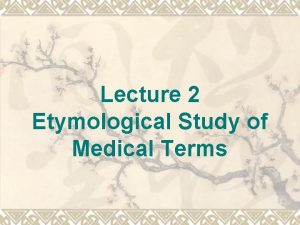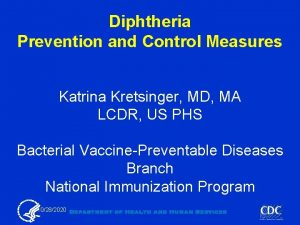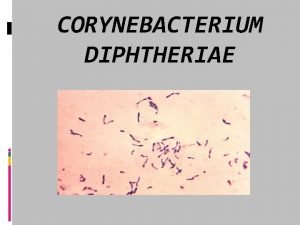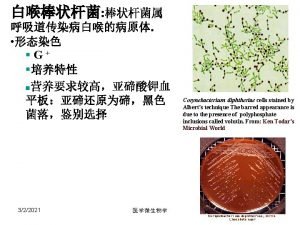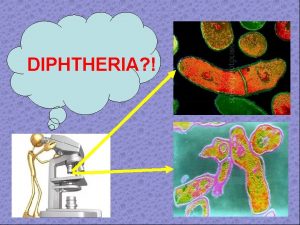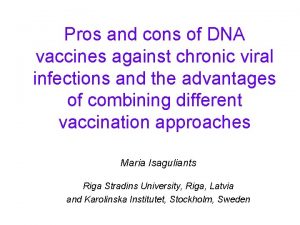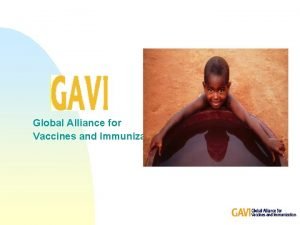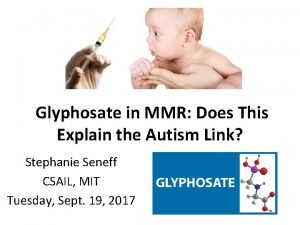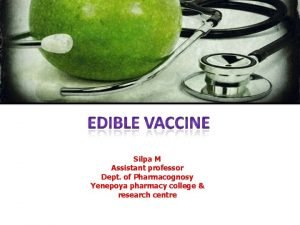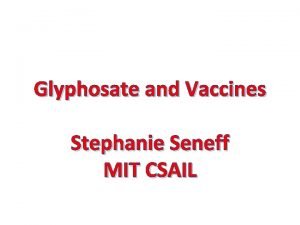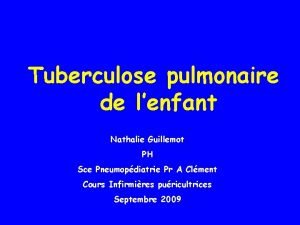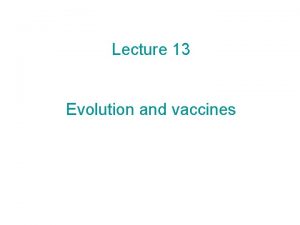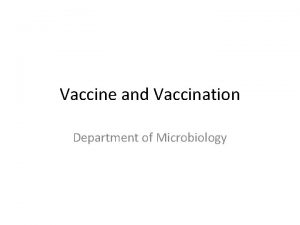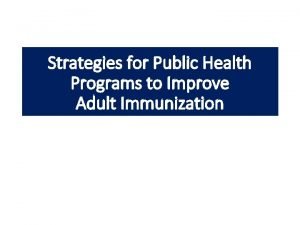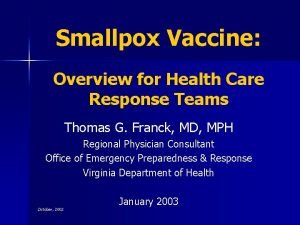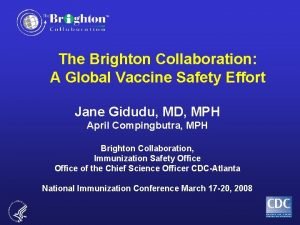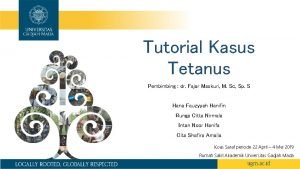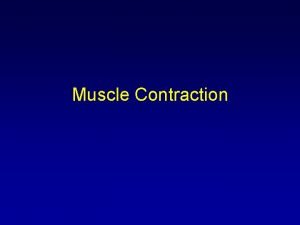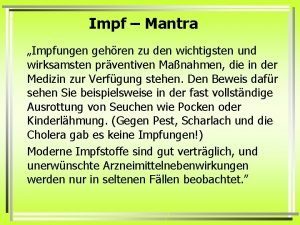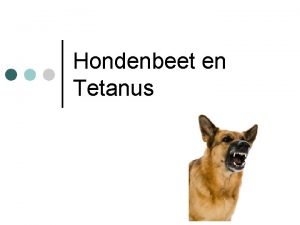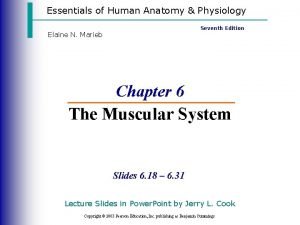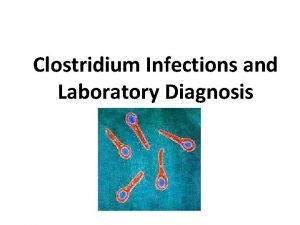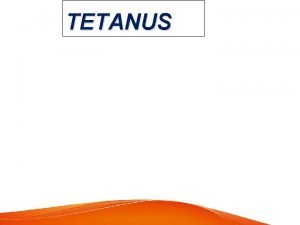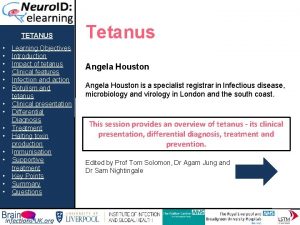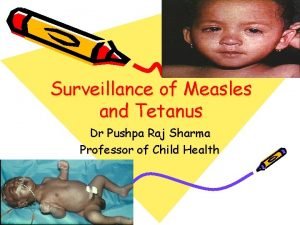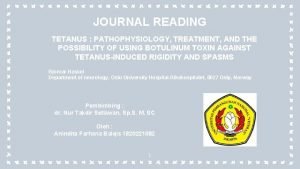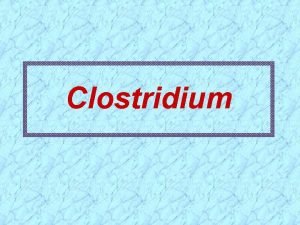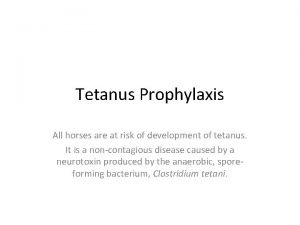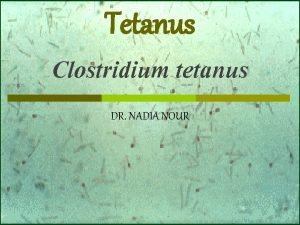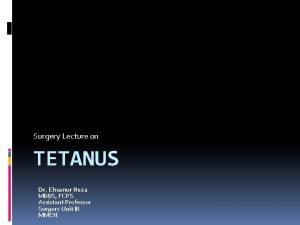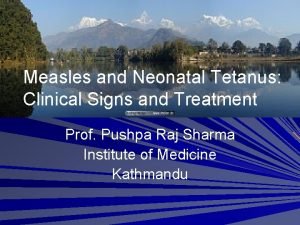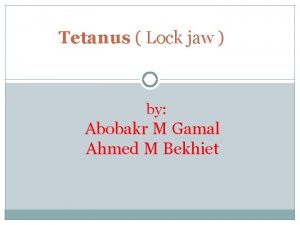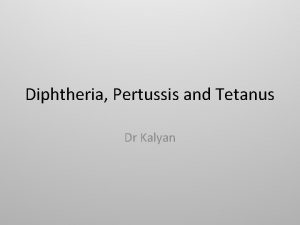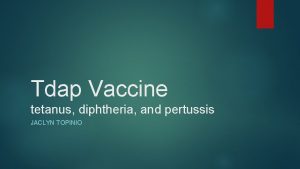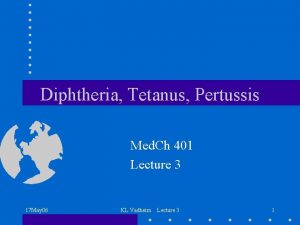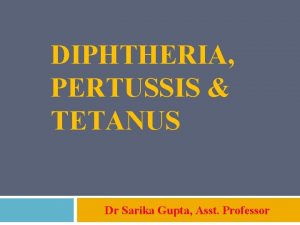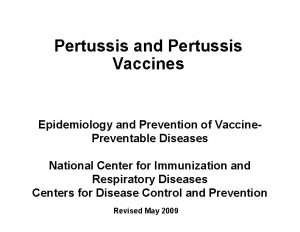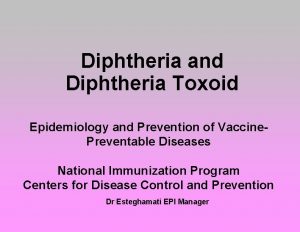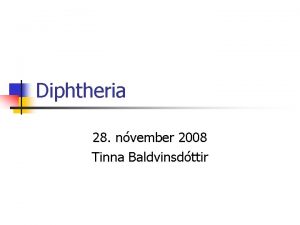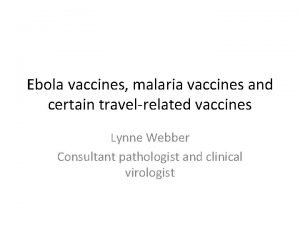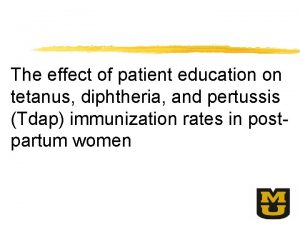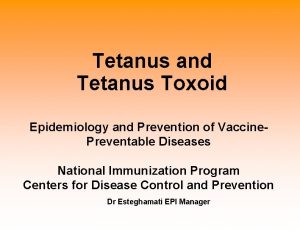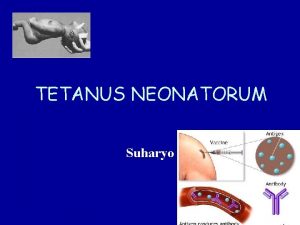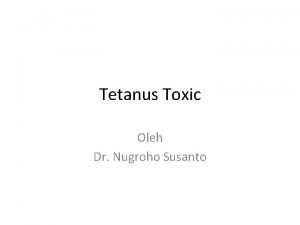Diphtheria Tetanus and Pertussis Diseases and Associated Vaccines















































- Slides: 47

Diphtheria, Tetanus and Pertussis Diseases and Associated Vaccines

Corynebacterium diphtheriae • Aerobic gram-positive bacillus • Toxin production occurs only when C. diphtheriae infected by virus (phage) carrying tox gene • If isolated, must be distinguished from normal diphtheroid • Toxoid developed in 1920 s

Diphtheria Clinical Features • Incubation period 2 -5 days (range, 1 -10 days) • May involve any mucous membrane • Classified based on site of infection – – – anterior nasal pharyngeal and tonsillar laryngeal cutaneous ocular genital

Pharyngeal and Tonsillar Diphtheria • Insidious onset • Exudate spreads within 2 -3 days and may form adherent membrane • Membrane may cause respiratory obstruction • Pseudomembrane: fibrin, bacteria, and inflammatory cells, no lipid • Fever usually not high but patient appears toxic


Tonsillar Diphtheria

Diphtheria - United States, 1940 -2005 Year

Diphtheria - United States, 1980 -2005 Year

Diphtheria Complications • Most attributable to toxin • Severity generally related to extent of local disease • Most common complications are myocarditis and neuritis • Death occurs in 5%-10% for respiratory disease

Diphtheria Epidemiology • Reservoir Human carriers Usually asymptomatic • Transmission Respiratory, aerosols Skin lesions • Temporal pattern Winter and spring • Communicability Up to several weeks without antibiotics

Diphtheria vaccine • Detoxified bacterial, protein toxin • Injectable, IM administration • Toxigenic Corynebacterium diphtheriae (infected with b phage) • Produced in horses (old) • First used in the U. S. in 1891 • Used only for treatment of diphtheria • Neutralizes only unbound toxin • Lifetime of Ab: 15 days – 3 weeks, wait 3 -4 weeks before giving toxoid. Only given once.

Manufacturing Process • Toxigenic strain of C. diphtheriae grown in Fenton medium with a bovine extract • After suitable growth, toxin purified from cells by centrifugation • Toxoided by incubation with formaldehyde for several weeks • Concentrated with ultrafiltration • Purified by precipitation, dialysis and sterile filtered • Adsorbed onto aluminum hydroxide, Al(OH)3

Routine DTa. P Primary Vaccination Schedule Dose Primary 1 Primary 2 Primary 3 Primary 4 Age 2 months 4 months 6 months 15 -18 months 4 -6 yrs 11 -12 yrs Every 10 yrs

Diphtheria Toxoids Adverse Reactions • Local reactions (erythema, induration) • Exaggerated local reactions (Arthustype) • Fever and systemic symptoms not common • Severe systemic reactions rare

Tetanus • First described by Hippocrates • Etiology discovered in 1884 by Carle and Rattone • Passive immunization used for treatment and prophylaxis during World War I • Tetanus toxoid first widely used during World War II



Clostridium tetani • Anaerobic gram-positive, spore-forming bacteria • Spores found in soil, animal feces; may persist for months to years • Multiple toxins produced with growth of bacteria • Tetanospasmin estimated human lethal dose = 2. 5 ng/kg

Tetanus Pathogenesis • Anaerobic conditions allow germination of spores and production of toxins • Toxin binds in central nervous system • Interferes with neurotransmitter release to block inhibitor impulses • Leads to unopposed muscle contraction and spasm

Tetanus Clinical Features • Incubation period; 8 days (range, 3 -21 days) • Generalized tetanus: descending symptoms of trismus (lockjaw), difficulty swallowing, muscle rigidity, spasms • Spasms continue for 3 -4 weeks; complete recovery may take months • Fatality rate ~90% w/o treatment ~30% w/ treatment

Neonatal Tetanus • Generalized tetanus in newborn infant • Infant born without protective passive immunity • Estimated >215, 000 deaths worldwide in 1998 Complications • Laryngospasm • Fractures • Hypertension • Nosocomial infections • Pulmonary embolism • Aspiration pneumonia • Death

>270, 000 cases worldwide per year

Tetanus Epidemiology • Reservoir Soil and intestine of animals and humans • Transmission Contaminated wounds Tissue injury • Temporal pattern Peak in summer or wet season • Communicability Not contagious

Tetanus toxins • Tetanolysin - possible role in establishing infection at inoculation site • Tetanospasm – accumulates intracellularly during log-phase growth – released into medium upon autolysis – Minimum human lethal dose ~ 2. 5 ng/kg

Tetanus disease • Tetanospasms – localized - spasm of muscles close to site of injection; weeks to months duration; rare but may precede generalized symptoms – generalized - 80% of cases • Complications of the spasms: – fractures of the long bones and vertebrae – asphyxia from glottic obstruction

Nervous system effects • Toxin travels up nerve endings by intraaxonal transport • Gains entry to neuromuscular junctions by binding to gangliosides • Interferes with release of neurotransmitters from presynaptic inhibitory fibers • Excitatory reflexes multiply unchecked, causing spasms

Tetanus Transmission • Not a communicable disease • The only vaccine-preventable infection that is not communicable • Disease acquired through exposure to bacterial spores in the environment – inoculation of bacterial spores into body by puncture or deep cut

Tetanus—United States, 1947 -2005 Year

Manufacturing Process • Growth of C. tetani in modified Latham broth in fermenters • Harvest extracellular toxin by filtration • Purify • Detoxify with formaldehyde for ~3 weeks • Adsorb with Alum adjuvant • Diafiltration

Tetanus Toxoid • Formalin-inactivated tetanus toxin • Schedule. Three or four doses + booster Booster every 10 years • Efficacy Approximately 100% • Duration Approximately 10 years • Should be administered with diphtheria toxoid as DTa. P, DT, Td, or Tdap

Pertussis (Whooping Couth) • Highly contagious respiratory infection caused by Bordetella pertussis • Outbreaks first described in 16 th century • Bordetella pertussis isolated in 1906 • Estimated 294, 000 deaths worldwide in 2002 • Primarily a toxin-mediated disease

Bordetella pertussis • Fastidious gram-negative bacteria • Antigenic and biologically active components: – pertussis toxin (PT) – – – filamentous hemagglutinin (FHA) agglutinogens adenylate cyclase pertactin tracheal cytotoxin

Pertussis Pathogenesis • B. pertussis binds to and multiplies on ciliated cells (respiratory mucosa). The infection is not systemic. • Inflammation occurs which interferes with clearance of pulmonary secretions • B. pertussis binds via at least 2 adhesion proteins to the ciliated cells • Filamentous hemagglutinin • Pertussis toxin (Ptx, A 5 B exotoxin) • Ptx is also released into the extracellular fluid and can affect host cells

Pertussis Clinical Features • Incubation period 5 -10 days (range 4 -21 days) • Insidious onset, similar to minor upper respiratory infection with nonspecific cough • Fever usually minimal throughout course of illness • Catarrhal stage 1 -2 weeks • Paroxysmal cough stage 1 -6 weeks • Convalescence Weeks to months

Pertussis Epidemiology • Reservoir Human Adolescents and adults • Transmission Respiratory droplets • Communicability Maximum in catarrhal stage Secondary attack rate up to 80%

Pertussis Among Adolescents and Adults • Disease often milder than in infants and children • Infection may be asymptomatic, or may present as classic pertussis • Persons with mild disease may transmit the infection • Older persons often source of infection for children

Pertussis Complications* Condition Percent reported Pneumonia 4. 9 Seizures 0. 7 Encephalopathy 0. 1 Hospitalization 16 Death 0. 2 *Cases reported to CDC 2001 -2003 (N=28, 998)

Pertussis Complications by Age *Cases reported to CDC 1997 -2000 (N=28, 187)

Pertussis—United States, 1940 -2005 Year

Pertussis—United States, 1980 -2005 Year

Pertussis (vaccines) • Killed Whole cell – old, not licensed in U. S. or Europe – still used in developing countries – relatively cheap • Acellular (a. P) – currently licensed in U. S. , Japan and Europe – some are recombinant – expensive

Pertussis-containing Vaccines • DTa. P (pediatric) – approved for children 6 weeks through 6 years (to age 7 years) – contains same amount of diphtheria and tetanus toxoid as pediatric DT • Tdap (adolescent and adult) – approved for persons 10 -18 years (Boostrix) and 11 -64 years (Adacel) – contains lesser amount of diphtheria antigen than DTa. P toxoid and acellular pertussis

Interchangeability of Different Brands of DTa. P Vaccine • Whenever feasible, the same DTa. P vaccine should be used for all doses of the series • Limited data suggest that “mix and match” DTa. P schedules do not adversely affect safety and immunogenicity • If vaccine used for earlier doses is not known or not available, any brand may be used to complete the series

DTa. P Adverse Reactions • Local reactions 20%-40% (pain, redness, swelling) • Temp of 101 o. F 3%-5% or higher • More severe adverse reactions not common • Local reactions more common following 4 th and 5 th doses

DTa. P Contraindications • Severe allergic reaction to vaccine component or following a prior dose • Encephalopathy not due to another identifiable cause occurring within 7 days after vaccination

DTa. P Precautions* • Moderate or severe acute illness • Temperature >105°F (40. 5°C) or higher within 48 hours with no other identifiable cause • Collapse or shock-like state (hypotonic hyporesponsive episode) within 48 hours • Persistent, inconsolable crying lasting >3 hours, occurring within 48 hours • Convulsions with or without fever occurring within 3 days *may consider use in outbreaks

DTa. P Vaccine Formulations
 Advantages and disadvantages of vaccines ppt
Advantages and disadvantages of vaccines ppt Aise medical term
Aise medical term Preventive measures of diphtheria
Preventive measures of diphtheria Corynebacterium
Corynebacterium Bull neck appearance
Bull neck appearance Diphtheria cdc
Diphtheria cdc Diphtheria
Diphtheria Dna vaccines pros and cons
Dna vaccines pros and cons Edible vaccines pros and cons
Edible vaccines pros and cons Global alliance for vaccines and immunization
Global alliance for vaccines and immunization Edible vaccine definition
Edible vaccine definition Is glyphosate in vaccines
Is glyphosate in vaccines Edible vaccines in pharmacognosy
Edible vaccines in pharmacognosy Glyphosate in vaccines
Glyphosate in vaccines Cancer vaccines
Cancer vaccines Tuberculose transmission
Tuberculose transmission Could vaccines breed viciousness
Could vaccines breed viciousness Hep b vaccines
Hep b vaccines Virulent
Virulent Hep b vaccines
Hep b vaccines Freeze market
Freeze market Brighton collaboration case definitions for vaccines
Brighton collaboration case definitions for vaccines Spacing out vaccines
Spacing out vaccines Difference between tetanus and tetany
Difference between tetanus and tetany Fajar tetanua
Fajar tetanua Fajar tetanua
Fajar tetanua Incomplete tetanus muscle contraction
Incomplete tetanus muscle contraction The staircase phenomenon
The staircase phenomenon Tetanus lüge
Tetanus lüge Tetanus hondenbeet
Tetanus hondenbeet Incomplete tetanus muscle contraction
Incomplete tetanus muscle contraction Tetanus vs summation
Tetanus vs summation Clostridia family
Clostridia family Htig vs ats
Htig vs ats Prophalaxysis
Prophalaxysis Tetanus
Tetanus Tetanus shot osha recordable
Tetanus shot osha recordable Tetanus
Tetanus Tetanus
Tetanus Interkalárne disky
Interkalárne disky Laatjevaccineren.be/tetanus-klem
Laatjevaccineren.be/tetanus-klem Definisi tetanus
Definisi tetanus Agedema
Agedema Hondenbeet tetanus
Hondenbeet tetanus Tetanus symptoms
Tetanus symptoms Hondenbeet tetanus
Hondenbeet tetanus Tetanus
Tetanus Tetanus def
Tetanus def
